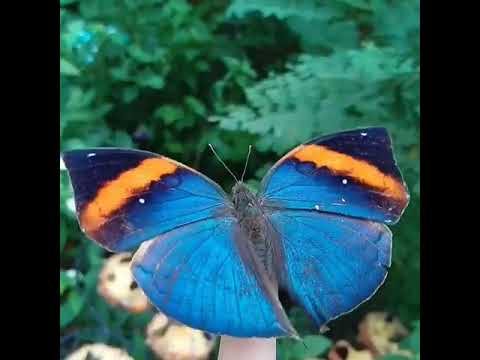Once on a trip to Spain, I visited an old stone monastery up in the mountains where one of the priests had retired after a long career as a missionary in the jungles of South America. He had a large collection of wonders, among which was a butterfly that looked exactly like a dead leaf. A picture of a similar insect is shown above. I was, and frankly still am, astounded by the faithfulness with which it mimicked the leaf. How did this come to be?
It is important to emphasize that I wanted to understand not why the butterfly had assumed a bland color or some other simple trait; rather I wanted to understand how it had come to look designed – with a stem, veins, blotches, a notch.
“Intelligent design” is a provocative phrase. Biologists have found themselves in a battle against creationism since Darwin's time. When I audited a course on evolution at Yale in 2012, I was struck by the insistence by the professor and the textbooks that evolution was purposeless. I sensed that underlying this insistence was a strong aversion to any hint of a creator or guiding intelligence. I see this same aversion in popular writing about evolution today, for example in Richard Dawkins. In Dawkins' case this aversion is so strong it led him to divert his career from biology to become a professional opponent of all things religious.
When I ask the question about design, I am not referencing intelligent design, understood as the action of some deity. Instead I am suggesting that much more modest intelligences may be playing a role.
Contemporary evolutionary biologists try not to speak of intention, and when such language does slip in, it is meant to be figurative. Yet, in "On the Origin of Species", Darwin devotes his very first chapter to "Variation under Domestication". This is a detailed consideration of how, under the actions of breeders, various types of animals become quite different in character, behavior and appearance. So Darwin starts his book with examples of how intent shapes evolution.
Perhaps you object to breeding being called natural selection, since human beings are involved. But then you will have to be consistent and explain how human beings are not part of nature. Otherwise, you will need to make a special exception for humans and their intelligence, and this leads away from natural explanations towards the very sorts of, let’s say extra-natural, arguments biologists are so keen to avoid.
In the case of dog breeding, one species (humans) is exerting selective pressure on another (dogs). How do we talk about intention in this setting? From the point of view of the dog, intention doesn't enter into the matter. The dog has no intention to improve his breed; he follows his instincts in a way that can be said to be mechanistic. A mate appears, the act is done, puppies result. The human on the other hand sets a goal and then manipulates the environment of the dog so as to achieve it.
The presence of a human in this scenario confounds our view of intentionality, because despite evolutionary biologists' insistence on its absence, I for one at least cannot think of myself as lacking it. If we take the evolutionists' contention at face value and posit that human breeders are not in fact using intention, then the breeders’ preference for a longer snout (in their dogs, that is) is somehow - what? An accident? An evolutionary advantage for the breeders themselves? This is certainly unclear.
Humans are not the only living creatures that put selective pressures on other creatures, thereby affecting the outcomes from natural variation. And just as humans do this for a reason – a goal – I see no reason why we cannot say that other organisms do the same.
Consider a bird, and its prey, a butterfly. A butterfly that looks like a leaf is shown in the video below. How did the undersides of the butterfly wings evolve to look so very much like a dead leaf?
My idea is that the bird does pattern matching, driving the evolution of the butterfly. As with the dog, there is no intention in the butterfly. Rather, the information processing in the bird's brain shapes its intention to find something that looks like food, and this intention interacts with the physical variation in the butterfly to drive the convergence of the butterfly’s phenotype to the least conspicuous form, that of a dead leaf. In this example, the bird’s intention works against it. This is a kind of jujitsu against the bird, though without intention on the part of the butterfly.
Thus, the reason the butterfly looks designed is that its pattern has been matched to the pattern of another unrelated object via the mediation of the bird. The mimicry is so precise because the bird has a detailed mental concept of what a dead leaf looks like. The bird designs the butterfly!
To the extent that such a mechanism of “intentional natural selection” exists, it is a vastly complex, decentralized process. I am not claiming some kind of vague but all encompassing "plan" in nature. But because nearly everything is connected in some way to nearly everything else (directly or indirectly), the overall effect seems, and is, harmonious. I am suggesting that intent really exists, not just in humans but in many creatures, and influences the physical world, in this case which butterflies get eaten and which do not.
In higher organisms like us and birds, these intentions take the form of ideas. It is difficult to argue that ideas don't exist, or don't influence the physical world. Entire cities exist because people had the idea to build them. Golden retrievers exist for a similar reason. And so, I would argue, for some other aspects of creation, that is, where an intelligent creature affects another organism.
As we look down the evolutionary tree, at some point we can no longer talk about intelligence. A bolder version of the proposed mechanism may require only organized behavior, or habits, and as we look at the evolutionary tree we can see habits all the way down. Even viruses might be said to have the “intention” to infect a cell under this broader definition.
Where these goals, these intentions, come from in the first place is a fascinating question in its own right. Presumably these too evolve, but how did they start? Is having intentions the mark of being alive?




